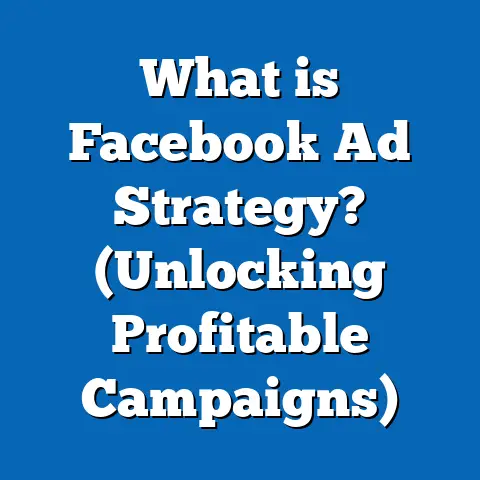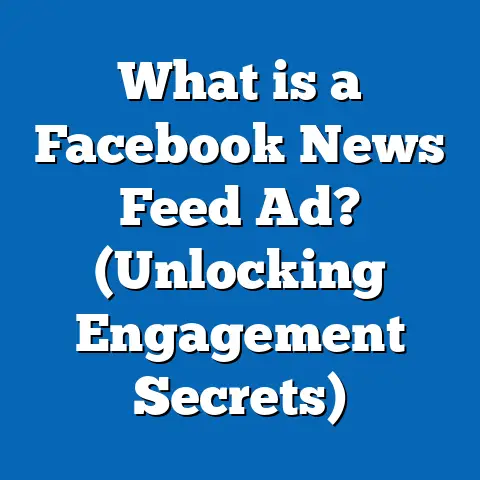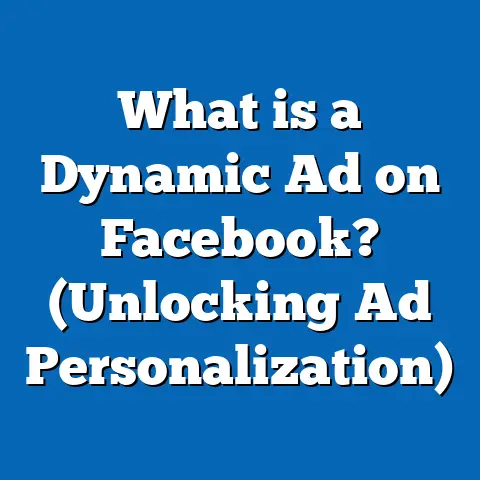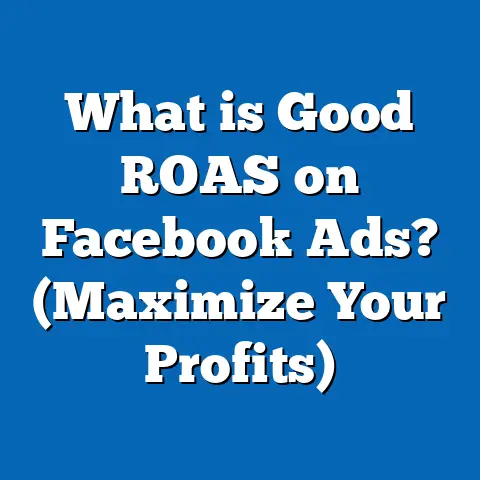What is a Good Budget for Facebook Ads? (Maximize ROI)
What is a Good Budget for Facebook Ads? (Maximize ROI)
Introduction
In the evolving landscape of digital marketing, Facebook advertising remains a cornerstone for businesses aiming to connect with their target audience effectively. With its staggering user base exceeding 2.9 billion monthly active users globally, Facebook offers an unparalleled platform for brands to build awareness, drive engagement, generate leads, and boost sales. However, one of the most challenging decisions marketers face is determining what constitutes a good budget for Facebook ads to maximize return on investment (ROI).
Spending too little risks insufficient data collection and limited reach, while overspending without strategy wastes valuable resources. The key lies in balancing your budget to align with your business goals, audience specifics, campaign objectives, and competitive environment. This guide dives deep into the nuances of Facebook ad budgeting, armed with original data insights, case studies, and actionable tips designed for marketing professionals and business owners alike. By the end, you’ll understand how to craft a budget that not only fits your business size but also optimizes performance and scales profitably.
Chapter 1: The Fundamentals of Facebook Ad Budgeting
Why Budgeting on Facebook Ads is Crucial
Facebook ads operate on an auction system where advertisers compete for impressions based on bids and budgets. The budget you set directly influences:
- Ad delivery frequency: How often your ads appear to your target audience.
- Learning phase efficiency: Facebook’s algorithm requires sufficient data to optimize ad delivery.
- Audience testing: With an adequate budget, you can test multiple audiences or creatives to identify winners.
- Return on investment: The right budget ensures you spend enough to generate meaningful conversions without overspending.
When your budget is too low, the ad system struggles to gather enough data to optimize, leading to high costs and inconsistent results. Conversely, an excessively large budget without strategy risks inefficient spending.
Key Terminology Simplified
Before diving deeper, understanding Facebook’s budgeting terms is essential:
| Term | Definition |
|---|---|
| Daily Budget | The average amount spent per day on an ad set or campaign. |
| Lifetime Budget | The total amount allocated over the full campaign duration. |
| Bid Strategy | How Facebook bids in auctions based on your budget and goal (lowest cost, cost cap, etc). |
| Cost Per Result (CPR) | Average cost for a specific action like clicks, leads, or purchases. |
| Frequency | Average number of times a user sees your ad during the campaign. |
Chapter 2: How Much Should You Spend on Facebook Ads? Industry Benchmarks and Insights
Average Costs and Metrics Across Industries
Data from WordStream’s 2024 digital advertising report provides a baseline for Facebook ad costs:
| Industry | Avg. CPC | Avg. CPM | Avg. CTR (%) | Avg. Cost Per Lead (CPL) |
|---|---|---|---|---|
| E-commerce | $0.70 | $9.50 | 1.59 | $15 – $30 |
| Finance | $3.77 | $17.00 | 0.56 | $40 – $60 |
| B2B | $3.33 | $15.00 | 0.78 | $35 – $70 |
| Education | $1.06 | $11.50 | 1.04 | $20 – $40 |
| Health & Beauty | $1.20 | $12.50 | 1.40 | $25 – $50 |
Interpretation:
- Lower CPCs generally indicate more affordable clicks; however, quality and conversion potential vary by industry.
- CTRs (Click Through Rates) reflect how compelling your ads are; higher CTRs often correlate with better audience targeting and creative.
- CPL (Cost Per Lead) varies widely and directly impacts budgeting decisions depending on your sales funnel value.
Minimum Budget Recommendations
Facebook’s internal guidance suggests:
- $5 daily minimum per ad set as a baseline.
- Effective campaigns often require $20-$50 daily to enable proper learning and optimization.
- Small businesses typically start with $300-$500 monthly, focusing on testing.
- Medium-sized companies may allocate $1,000-$5,000 monthly, scaling based on results.
- Large enterprises often invest $10,000+ per month, managing multiple campaigns simultaneously.
Why Starting Small and Testing Pays Off
New advertisers should avoid committing large budgets upfront without data. Testing different creatives, audiences, and placements with smaller budgets allows Facebook’s algorithm to learn what works before scaling spend efficiently.
Chapter 3: Factors That Influence Your Optimal Facebook Ad Budget
1. Campaign Objectives Impact Budget Size
Your campaign objective significantly shapes budget allocation:
| Objective | Budget Impact | Explanation |
|---|---|---|
| Brand Awareness | Moderate | Requires broad reach; focus on CPM-based bidding for impressions. |
| Lead Generation | Higher | Requires optimized bidding with stronger focus on conversions or leads; generally costlier per action. |
| Sales/Conversions | Highest | Competitive objectives; requires refined targeting and higher spend per conversion. |
| Engagement | Varies | Can be moderate or low depending on engagement type (likes vs comments). |
| App Installs | Medium | Cost depends on app category and audience value; CPC-focused. |
2. Audience Size and Targeting Specificity
- Broad audiences require larger budgets to maintain frequency without fatigue.
- Narrow targeting tends to have higher costs but better relevance and conversion potential.
- Retargeting audiences are smaller but often yield higher ROI at a lower cost per conversion.
3. Sales Cycle Length Affects Budgeting Strategy
Businesses with longer sales cycles (e.g., B2B software) need sustained budgets for nurturing leads through retargeting and content marketing.
4. Industry Competitiveness Drives Cost
Highly competitive sectors like finance or insurance require larger budgets to win auctions and maintain visibility.
Chapter 4: Crafting Your Facebook Ad Budget Plan
Step-by-Step Approach
- Define Clear Objectives: Awareness, lead generation, sales?
- Estimate Average Costs: Use industry benchmarks relevant to your niche.
- Calculate Expected Volume: How many conversions/leads do you need monthly?
- Set Initial Budget: Based on expected volume × average cost per result + testing buffer.
- Test Multiple Audiences & Creatives: Allocate smaller budgets to test variations.
- Analyze Results & Optimize: Shift budget toward best-performing segments.
Example Calculation: Small E-commerce Store
- Objective: Drive 100 sales/month
- Avg Cost Per Purchase: $20
- Base Budget Needed = 100 × $20 = $2,000/month
- Add 20% buffer for testing & optimization = $2,400/month
- Daily budget ≈ $80
This budget ensures enough scale to collect data while allowing optimization cycles.
Chapter 5: Leveraging Campaign Budget Optimization (CBO)
What is CBO?
Campaign Budget Optimization lets advertisers set one central budget at the campaign level rather than individual ad sets. Facebook automatically distributes spend dynamically among ad sets based on real-time performance signals.
Benefits of CBO
- Automatically allocates more budget to winning ad sets.
- Reduces manual management time.
- Improves overall campaign ROI by focusing spend on top performers.
Case Study: Apparel Brand Testing CBO vs Manual Budgeting
A mid-sized apparel company ran two identical campaigns over two months:
| Metric | Manual Budgeting | CBO |
|---|---|---|
| ROAS | 3.2x | 4.5x |
| Cost per Conversion | $18 | $12 |
| CPA | $18 | $12 |
Result: The CBO campaign outperformed manual budgeting by allocating more spend to better-performing ad sets faster.
Chapter 6: Scaling Your Facebook Ad Budget Efficiently
Gradual Increases Avoid Learning Phase Reset
Facebook’s algorithm requires roughly 50 conversions per week per ad set to exit the learning phase fully.
To avoid performance drops when increasing budgets:
- Increase budgets by no more than 10-20% every 2-3 days.
- Monitor key metrics like CPA, CTR, ROAS closely after each increase.
- Pause or adjust if costs spike or conversions drop.
Expanding Audience Targeting When Scaling
Start with core audience targeting and gradually add:
- Lookalike audiences based on converters.
- Interest-based segments similar to winning audiences.
- Retarget warm audiences for maximum efficiency.
Chapter 7: Comparing Facebook Ad Budgets with Other Platforms
CPC & CPM Comparison Table
| Platform | Avg CPC | Avg CPM | Suitable For | Notes |
|---|---|---|---|---|
| $0.97 | $11.20 | Broad consumer targeting | Flexible budgets; strong targeting | |
| Google Ads | $1-$2 Search | N/A | High intent search traffic | Higher minimum spends |
| LinkedIn Ads | $5-$7 | N/A | B2B targeting | Expensive but highly targeted |
| Instagram Ads* | Comparable | Comparable | Visual & younger demographics | Managed via Facebook Ads Manager |
*Instagram ads run through the same platform as Facebook ads, sharing budgets and targeting options.
Chapter 8: Practical Examples of Budget Allocation Models
Example 1: Small E-commerce Brand ($1,000 Monthly)
- Brand Awareness: $300 (CPM focus)
- Website Traffic: $400 (CPC focus)
- Retargeting/Conversions: $300 (CPA focus)
Rationale: Awareness builds initial pipeline; traffic drives visits; retargeting converts warm leads.
Example 2: SaaS Company Targeting B2B Leads ($4,000 Monthly)
- Lead Generation Campaigns: $3,000 (LinkedIn + Facebook split)
- Retargeting Warm Audiences: $800
- Content Engagement/Brand Building: $200
Chapter 9: Metrics That Matter for Budget Optimization
Tracking these KPIs helps refine budget allocation:
- Return on Ad Spend (ROAS): Revenue generated per dollar spent.
- Cost Per Acquisition (CPA): Cost to acquire one customer/lead.
- Click Through Rate (CTR): Percentage of users clicking ads.
- Frequency: Number of times each user sees your ad; too high leads to fatigue.
- Conversion Rate: Percentage of clicks converting into customers/actions.
Chapter 10: Latest Trends Impacting Your Facebook Ad Budget in 2024
AI-Powered Bid & Budget Automation
Facebook increasingly relies on AI for real-time bid adjustments and budget allocation—requiring advertisers to provide enough budget data for effective machine learning optimization.
Privacy Changes & Impact on Tracking
iOS privacy updates limit third-party tracking accuracy, increasing reliance on first-party data and broader targeting strategies—potentially increasing costs due to less precise attribution.
Growth of Video & Reels Ads
Video ads demand higher budgets but offer superior engagement and brand recall—especially important for awareness-focused campaigns.
Chapter 11: Common Mistakes in Facebook Ad Budgeting & How to Avoid Them
Mistake #1: Setting Budgets Too Low
Insufficient budgets prevent Facebook from exiting the learning phase, resulting in poor optimization and high costs.
Fix: Allocate at least $20 per day per ad set initially.
Mistake #2: Increasing Budgets Too Quickly
Sudden large jumps reset learning phases and cause cost spikes.
Fix: Scale gradually by 10–20% increments every few days.
Mistake #3: Ignoring Audience Overlap
Overlapping audiences can cannibalize your campaigns leading to inefficient spend.
Fix: Use Facebook’s Audience Overlap Tool; separate campaigns or exclude overlapping segments.
Mistake #4: Neglecting Retargeting Budgets
Retargeting usually has better ROI but is often underfunded.
Fix: Dedicate at least 20–30% of your total budget to retargeting campaigns.
Chapter 12: Tools & Resources to Manage Your Facebook Ad Budget Effectively
- Facebook Ads Manager: Central tool for setting budgets, monitoring spend, and optimizing campaigns.
- Facebook Analytics / Meta Business Suite: Offers deeper insights into performance metrics.
- Third-party tools like AdEspresso or Revealbot: Provide automation capabilities for budget management.
- Google Sheets or Excel Templates: For manual tracking and forecasting budgets against KPIs.
Conclusion: How to Determine Your Good Facebook Ad Budget (Key Takeaways)
- Know Your Objectives: Align budget size with campaign goals—whether awareness or conversions.
- Use Industry Benchmarks as Starting Points: Average CPCs and CPLs guide initial budgeting.
- Start Small & Test: Begin with smaller daily budgets ($20+) to gather data without overspending.
- Leverage Campaign Budget Optimization: Let Facebook allocate spend dynamically across ad sets.
- Scale Gradually: Increase budgets in small increments while monitoring KPIs closely.
- Dedicate Funds to Retargeting: Retargeting offers some of the best ROIs.
- Adjust for Industry & Competition: High competition requires larger budgets.
- Monitor Frequency & Avoid Ad Fatigue: Optimize audience size relative to budget.
- Keep Up with Platform Changes: Privacy updates and new ad formats affect budgeting strategies.
By applying these principles grounded in data and experience, you will not only find a good budget but also maximize your ROI from Facebook advertising campaigns—turning ad spend into measurable business growth.
If you want customized budgeting templates or further help in creating a tailored ad budget plan based on your specific business model or industry vertical, just ask!






